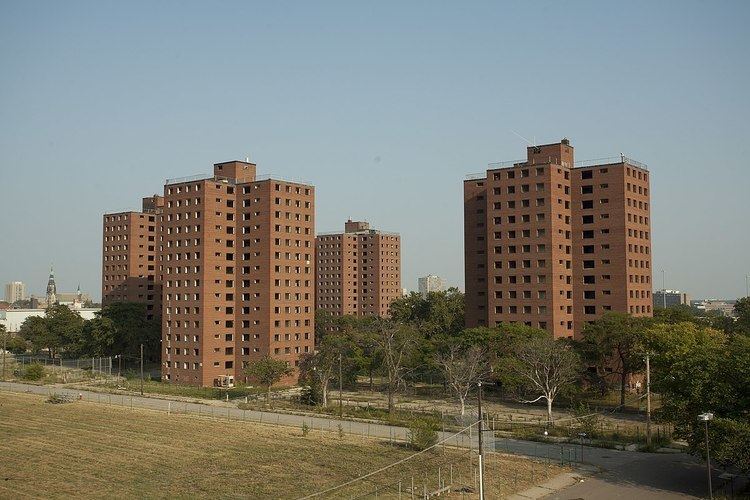Type Residential Completed 1942-1952 Height 46 m Floors 14 Architecture firm Harley Ellis Devereaux | Country United States Floor count 14 Opened 1952 Town or city Detroit Groundbreaking 1935 | |
 | ||
Address 2700 St. Antoine Street Similar Jeffries Projects, Public housing in Detroit, Herman Gardens | ||
The Brewster-Douglass Housing Projects (officially named the Frederick Douglass Homes, and alternately named Frederick Douglass Projects, Frederick Douglass Apartments, Brewster-Douglass Homes, and Brewster-Douglass Projects) were the largest residential housing project owned by the city of Detroit, located in the Brush Park section on the east side of Detroit, Michigan, near the Chrysler Freeway, Mack Avenue and St. Antoine Street. The housing project is named after Frederick Douglass, African American abolitionist, author, and reformer.
Contents
The complex was home to such notable figures as Diana Ross, Mary Wilson, Florence Ballard, Lily Tomlin, Loni Love, and Etterlene DeBarge, during their early years. The claymation animated series, The PJs, was based on the housing project, as well. It was also seen in a screenshots for the movie Dreamgirls, as well as D12's debut music video. RuPaul mentions the Brewster Projects in the intro of the 1992 song, "Supermodel (You Better Work)".
Hastings Street
Hastings Street was the center of black culture in Detroit between the 1920s and 1950s.. Located at the southern edge of the future Brewster-Douglass Homes, the street was the home of innumerable salons and entertainment venues. With the addition of the high-rises and an influx of people moving into the housing, Hastings Street was billed as the place you could fulfill any conceivable need. Hastings Street was most famously referenced in the John Lee Hooker song, "Boogie Chillen'".
The I-75 corridor is now in place of this important African American landmark. The (Walter P.) Chrysler Freeway was constructed between 1963 and 1968.
Brewster-Douglass Homes
The Brewster Project and Frederick Douglass Apartments were built between 1935 and 1955, and were designed by Harley, Ellington & Day of Detroit. The Brewster Project began construction in 1935, when First Lady Eleanor Roosevelt broke ground for the 701-unit development; the first phase, consisting of low-rise apartment blocks, was completed in 1938. An expansion of the project completed in 1941 brought the total number of housing units to 941. The Frederick Douglass Apartments, built immediately to the south of the Brewster Project, began construction in 1942 with the completion of apartment rows, two 6-story low-rises, and finally six 14-story high rises completed between 1952 and 1955. The combined Brewster-Douglass Project was five city blocks long, and three city blocks wide, and housed anywhere between 8,000 and 10,000 residents, at its peak capacity.
The Brewster-Douglass Project were built for the "working poor"; the Detroit Housing Commission required an employed parent for each family before establishing tenancy. As the Commission became less selective, crime became a problem in the 1960s and 1970s, and the projects eventually fell into disrepair. The Frederick Douglass Apartment towers were converted to senior housing.
In 1991, the low-rise apartment blocks north of Wilkins Street (the original Brewster Project) were demolished, and by 1994 were replaced with 250 townhomes. This new public housing, administratively distinct from the Fredrick Douglass Homes project, was dubbed the "Brewster Homes", and still exists today.
In the meantime, the remaining housing on the project site continued to deteriorate. Two of the six 14-story Frederick Douglas Apartments towers, 303 and 304, were demolished in 2003, in an effort to consolidate living space and reduce maintenance costs. By 2008, only 280 families remained in the Frederick Douglass Homes complex, and the decision was made to shut down the housing entirely. The buildings south of Wilkins street were left abandoned after that date.
On July 29, 2013, 23-year-old French artist Bilal Berreni was found dead from a gunshot wound on the property of Brewster-Douglass, having last been seen the day before. Found without identification, Berreni's body was not identified for 7 months. Jasin Curtis pleaded guilty to second degree murder and was sentenced in June 2015; two others, Drequone Rich and Dionte Travis, await trial scheduled for September 2015 for this crime.
Demolition of the remaining buildings of the Frederick Douglass Homes began on September 4, 2013. Demolition was substantially complete by the end of August, 2014.
From historic marker on the site of Brewster Homes
Future
On March 9, 2012, Mayor of Detroit Dave Bing announced that the Detroit Housing Commission planned to request funding from the Department of Housing and Urban Development to demolish all remaining housing on the Frederick Douglass Homes site, but redevelop the abandoned Brewster-Wheeler Recreation Center. The vacant land would then be developed as affordable housing and commercial space. The demolition was announced on November 15, 2012.
Constituent buildings
The six concrete-framed towers were designed in the Modern movement architectural style and faced in brick. They are virtually identical in look and each rise to the height of 15 floors.
Schools
The buildings were zoned to the following Detroit Public Schools facilities:
